Tanner Simpson
Member
I have been trying the brick pattern for some time now. It always splits apart while drilling, even when drilling a pilot hole. No matter how slow, it splits. Any ideas? I'm using CA glue, but have tried 24 hour epoxy. No luck.
Acrylic, with G10. I tried different woods with G10 in the past.What material are you trying to glue?
What adhesive should I use?Heat is the enemy of those adhesives.
YesAre you scuffing the glue faces?
No, it just randomly comes apart. I normally am able to finish drilling though.Am I correct in saying it breaks when you hit the bottom of the blank?
I have used lot of G10 inlays and find only system three T-88 will work for pen segmenting. First of all you have to scuff up the g-10 , wipe clean and use the system three T-88 epoxy. Don't over tighten and let cure for. three days. Drill with a very sharp bit, slowly. Turning to be done with carbide tools.Acrylic, with G10. I tried different woods with G10 in the past.
What about card stock? Would that work better?I have used lot of G10 inlays and find only system three T-88 will work for pen segmenting. First of all you have to scuff up the g-10 , wipe clean and use the system three T-88 epoxy. Don't over tighten and let cure for. three days. Drill with a very sharp bit, slowly. Turning to be done with carbide tools.
G-10 is a mixture of fiberglass and epoxy and is very hard to machine.
Try cutting with band saw wood blade will dull blade very fast, I cut my G-10 with shears and table saw carbide tip blade.
end results G-10 not a good product to use in segmenting pen's.
Good luck!!!!
Not sure I can quite picture what you're saying to do. You just wrap it with gauze and drizzle CA on the blank? May I ask what you are drilling on (lathe/drill press)?What Mannie (Monte) said. In some cases of segments, it is not about the adhesive, it is about strength and integrity of the whole. The old guys were well aware of this and originally wrapped two or three layers of thread or string around the blank (but now several layers of gauze) and CA the heck out of it. THEN drill.
Not sure if you ever thought about this or not, but did you ever wonder why a 5/8 in blank would blow out when drilling with a 3/8 in bit, but drill the same bit through a 2x4 and not even a hint of a blowout. -> Integrity of the wood. In some of my segments, gauze and CA is precisely what I use to keep it from coming apart while drilling.
Card stock works well. Also if you have to use G-10 west system G-Flex works very good , designed for the boat industry..What about card stock? Would that work better?
Yes. Wrap with layers of gauze and CA the heck out of it.Not sure I can quite picture what you're saying to do. You just wrap it with gauze and drizzle CA on the blank? May I ask what you are drilling on (lathe/drill press)?
His problem is with the material he chose to try to do a segmenting with. It would be different if he did an inlay where the blank is not cut apart and he would have a better chance. But being he cut the blank apart and this G10 material is not friendly to being glued something like delrin isn't. his problem is finding an adhesive that will work. I would try the System3 T88 epoxy too. It is my epoxy of choice on all types of segmenting.If your blank is square/rectangular, why not just clamp it together while you drill it and then, while it's still clamped up, insert your tube with the right sort of adhesive and wait for the adhesive to cure? Just looking at the photo, it looks like the adhesive hasn't bonded all that well with the blank so perhaps there is some way to get a better bond? And if the adhesive isn't bonding real well, could the pen come apart one day? Is there a different drill or drilling technique that would place less outward pressure on the join? Something that will remove the swarf from the drill hole as fast or faster than the drill bit will make it?
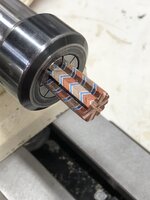
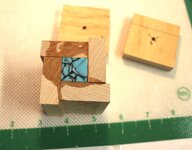
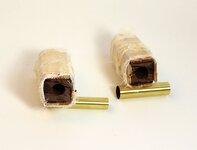
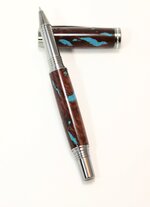
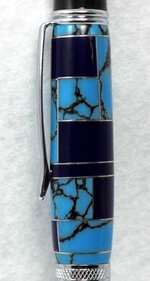
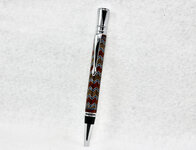
John, I am a little OCDC when it comes to sizing and measuring. I try to do with wood what is only possible with metal in measuring - and it does not always work that good for me, but I keep trying. I mark the center spots precisely before wrapping with gauze. On the stripe pen, even .1 mm off of center shows up when turning. (You know that but I wrote it for the benefit of others.) I make my stripe pens two different ways - square and octagon, but always with solid center and drilling the hole after the blank is made. (I mention the Mark James method below) Wrapping is done after the parts are in place as a blank.Now I have heard this method of wrapping gauze and CA so many times here for over 15 years, and I am working on a method that I think will help in the future but that is for another day. My question is if you wrap all this gauze and CA how in the world do you hold the blank so it can be drilled true down the center. Are you returning it round so it can be held by a chuck of some sort. ?? Now I am an old timer here so do not pull wool over my eyes. I want to know your true method so it can be documented for future inquiries. If you have photos, even better. Go for it.
John T: You should pay attention to how or to who/whom you are addressing questions. My "long answer" was to YOUR question because you were not asking the OP or new pen turner. Just look at the below:Hank your reply is long and confusing and how is a newbie going to understand this?
For clarification, your above question is not addressed to the new turner or the OP, but it followed two well experienced posts on the gauze subject. And that question was followed up with the quote-question below - that a new person would not know. Therefore your question, and the answer you were seeking, were not related to the inexperienced.JohnT: Now I have heard this method of wrapping gauze and CA so many times here for over 15 years, and I am working on a method that I think will help in the future but that is for another day.
No one can read your mind JohnT. One minute you want detailed explanations so that "the wool can't be pulled over your eyes"; the next minute you say the answer is too long for you - but you dismiss it with "a newbie can't understand it". Don't you mean an "Oldie" can't understand it? Old age does strange things to us, John!JohnT: Now I am an old timer here so do not pull wool over my eyes. I want to know your true method so it can be documented for future inquiries.
John,.....Again if someone has a method to use gauze on a segmented blank that needs dead on center hole drilling Love to see it. Thanks.
This is sort of my thought but again would need to mark centers ahead of time and then add gauze and then turn round to fit my collet chuck. Probably the easiest way if doing with gauze. Thanks.John,
The closest thing that works for me is to wrap several layers of gauze smoothly around the blank and apply thin CA. when dry, mark the center of the blank and turn round between centers using a small spur drive if necessary. Once the blank is round, I use my collet chuck to hold the blank while drilling. This has worked well for my needs but YMMV.
It may work but it is not sturdy enough in my opinion. It will flex. Now maybe add some popsicle sticks under it to help make more stout.Not a segmented myself but love how some of them look.
In skimming through this, the idea of heat shrink tube would seem to be a good one.
Sent from my iPad using Tapatalk
John - It would be pretty light duty - even multiple layers . My thought to stiffen it up would be wood coffee stir sticks that would help keep things round since they are narrow compared to popsicle sticks.It may work but it is not sturdy enough in my opinion. It will flex. Now maybe add some popsicle sticks under it to help make more stout.
Hey it could work. The stress will be from drilling. Turning you can control better with light cuts.John - It would be pretty light duty - even multiple layers . My thought to stiffen it up would be wood coffee stir sticks that would help keep things round since they are narrow compared to popsicle sticks.
Thanks to all who replied. I finally got one drilled. I glued popsicle sticks to the side of it, which worked for me. Drilled real slow, took about 30 minutes. But it worked.I have been trying the brick pattern for some time now. It always splits apart while drilling, even when drilling a pilot hole. No matter how slow, it splits. Any ideas? I'm using CA glue, but have tried 24 hour epoxy. No luck.
